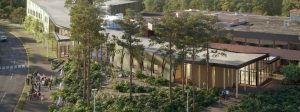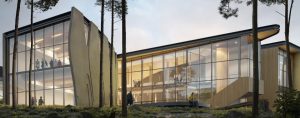
Architectural rendering of the front of the National Centre for Indigenous Laws at UVic, to be completed in 2024. @uvic.ca
VICTORIA – Construction is now underway for the long-awaited National Centre for Indigenous Laws (NCIL) at the University of Victoria.
The Law Foundation of British Columbia announced it is increasing its total commitment to NCIL to $11 million, boosting their initial $5-million funding commitment to help complete the new centre. The foundation is UVic Law’s largest donor since the inception of the faculty in 1976.
“The Law Foundation of BC is honoured to support the construction of a beautiful and fitting new home for scholars who are working to advance the recovery and resurgence of Indigenous laws. This new space will help breathe life into the learning and work that takes place there, where teachers and students support Indigenous communities seeking to articulate and apply their laws to contemporary challenges. UVic is leading the way in transforming what legal education means and the new centre will be at the heart of that transformation,” said Josh Paterson, Executive Director of the Law Foundation of BC.
The law foundation’s latest gift is in addition to commitments from the BC government of $13 million in 2020 and $9.145 million from the federal government in 2019.

Architectural rendering of the back view of the new NCIL as seen from the woods. @uvic.ca
Construction of the National Centre for Indigenous Laws is on track for completion in Fall 2024.
The building aims to respect and learn from the environment, using best practices for environmental stewardship and management such as the use of mass timber to provide a carbon sink and reduce emissions from prefabricated construction materials, stormwater management and considerations to solar orientation.
By carefully removing trees and protecting the Bowker Creek watershed, the CaGBC Leed Gold building will be both beautiful and sustainable. The project team is working to incorporate wood from some of the larger trees for use as exposed structural elements within the building atrium spaces. The smaller trees have been donated locally to Songhees and Esquimalt First Nations.
The NCIL building design involved three architectural firms, including Two Row Architect as the prime consultant, a native-owned business in Ontario operated from the Six Nations of the Grand River First Nation and Tkaronto. Teeple Architects and Low Hammond Row Architects were also instrumental in NCIL’s design. Construction management company, Chandos, is partnering with the Victoria Native Friendship Centre to employ local carpenters and labourers to support the project. In addition, the civil and excavation subcontractor is an Indigenous-owned company from Duncan, BC.
The NCIL was designed in respectful relationship to the headwaters of Bowker Creek and will recognize Spirit of Place through Coast Salish designs, signage and public art that reflect modern and historic values of the Coast Salish peoples.
The NCIL building has been designed to reflect and honour the long-standing relationships between the law school and the Songhees, Esquimalt and WSÁNEĆ peoples. It will house the joint degree program in Canadian Common Law and Indigenous legal orders (JD/JID), and the Indigenous Law Research Unit.
“This physical structure represents a sanctuary where our laws, which enable us to be peoples, will be safe, and where both Indigenous and non-Indigenous students will learn about those laws, creating the foundation to a multijuridical Canada,” said Val Napoleon, Acting Dean of Law, Professor, and Law Foundation Chair of Indigenous Justice and Governance.
The building, a 2,440 square-meter addition to the current UVic Fraser law building, will also house the Environmental Law Centre, the Business Law Clinic, and the Access to Justice Centre, an Elders’ room and garden, and spaces for gathering, ceremony, and sharing of histories and knowledge. The design of the building will facilitate place-based learning and will create a flow between the old and new buildings and indoor/outdoor space including an outdoor learning deck, a sky classroom and a maker’s room.
Business Examiner Staff


